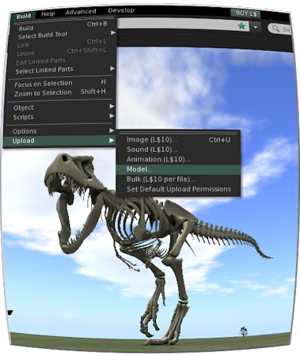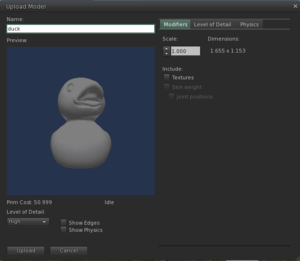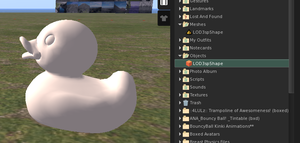Difference between revisions of "Mesh/Uploading a simple mesh"
| Line 1: | Line 1: | ||
__NOTOC__ | __NOTOC__ | ||
[[ | [[Image:MeshWalkthrough-Simple_Mesh_Upload-Splash.png|300px]] | ||
Uploading a mesh is a straightforward process, similar to how you would upload an animation or texture. This walkthrough will cover the workflow for uploading a basic object with basic properties. If you're new to mesh, this is where you'll want to get started. This walkthrough will bypass a lot of the more complex customization and advanced features of mesh; we'll get into some of those in later walkthroughs. | Uploading a mesh is a straightforward process, similar to how you would upload an animation or texture. This walkthrough will cover the workflow for uploading a basic object with basic properties. If you're new to mesh, this is where you'll want to get started. This walkthrough will bypass a lot of the more complex customization and advanced features of mesh; we'll get into some of those in later walkthroughs. | ||
Revision as of 12:13, 8 October 2010
Uploading a mesh is a straightforward process, similar to how you would upload an animation or texture. This walkthrough will cover the workflow for uploading a basic object with basic properties. If you're new to mesh, this is where you'll want to get started. This walkthrough will bypass a lot of the more complex customization and advanced features of mesh; we'll get into some of those in later walkthroughs.
Obtain a Second Life compatible mesh file
The first step is to get a mesh file onto your computer that you want to upload to SL. SL's mesh import is able to read COLLADA (".dae") files.
- Click on this link -- https://collada.org/owl/download.php?sess=0&parent=126&expand=1&order=name&curview=0&binary=1&id=698/ -- to download the "duck.dae" COLLADA file.
- Save the file anywhere on your hard drive where you can find it subsequently.
Upload the mesh file to Second Life
Next, take the file that you downloaded to your computer and upload it to SL. (Note that during beta, uploading is free!)
- Open the main menu "Build" menu, choose "Upload", click "Model...".
- (Alternately, open your Inventory View, click the "+" menu button, "Upload" > "Model...").
- This will cause a file dialog box will open.
- Find and select the "duck.dae" file from your computer.
- The Import Model window will then appear.
- Click the "Generate LOD" button at the top of this window.
- The viewer will take a moment to process this, then the "Upload button" will become clickable.
- Click the "Upload" button.
- You will see 2 new assets in your inventory:
- One will appear in your inventory's top-level "Meshes" folder, the other in your top-level "Objects" folder.
- These will appear as "LOD3spShape" for the duck object.
- We only care about the asset in your "Object" folder right now.
Add your mesh object to the world
You should now be able to manipulate your mesh as if it were like any other object in your inventory.
- Find your "LOD3spShape" object in your "Objects" folder; if you're having trouble or have a large inventory, use your inventory's "RECENT" tab view.
- Drag the new object from your "Objects" folder to anywhere on the ground where you have permissions to build.
- A duck model will appear on the ground.
- You can use the duck mesh as you would any other object -- scale it, texture it, attach it, script it, whatever you like.
Experiment with other Mesh files

You can also experiment uploading other files from COLLADA's repository. Due to the fact that Mesh is still in beta, be warned that you may not have success with all of these.
- Download any ".dae" file from the COLLADA public repository.
- Follow the above steps to upload this file to SL.


